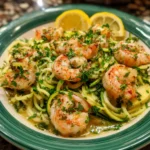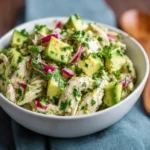Vegan Thai Peanut Noodles: A Flavorful, Plant-Based Delight
Craving a dish that’s rich, creamy, savory, and entirely plant-based? Look no further than Vegan Thai Peanut Noodles. This vibrant, aromatic dish brings together the bold flavors of Southeast Asia with wholesome, nourishing ingredients to create a meal that’s as satisfying as it is healthy. Whether you’re a long-time vegan or simply exploring meatless meals, this recipe offers a delicious gateway into the world of plant-powered cuisine.
The History Behind Thai Peanut Noodles
While traditional Thai cuisine doesn’t typically feature peanut sauce in its most authentic noodle dishes, the concept of peanut-based sauces has deep roots across Southeast Asia. Peanuts were introduced to Asia by Portuguese traders in the 16th century and quickly became integrated into local cooking due to their rich flavor and high protein content. Over time, various cultures developed unique interpretations using peanuts—such as Indonesia’s famous gado-gado and satay sauces.
In Western countries, particularly North America, Thai-inspired peanut noodles emerged as a popular fusion dish during the late 20th century. Chefs and home cooks alike began combining rice noodles with creamy peanut sauces infused with soy sauce, lime, garlic, and chili for a sweet-savory-spicy profile. The vegan version evolved naturally as plant-based eating gained popularity, replacing fish sauce and honey with tamari, maple syrup, and other cruelty-free alternatives. Today, Vegan Thai Peanut Noodles are celebrated globally as a comfort food that’s both indulgent and aligned with ethical dietary choices.
Ingredients Breakdown: What Makes This Dish Shine
The magic of Vegan Thai Peanut Noodles lies in its balance of textures and flavors—creamy, tangy, spicy, nutty, and umami—all coming together through carefully selected ingredients. Here’s a detailed look at each component:
- Rice Noodles: These gluten-free noodles made from rice flour and water cook quickly and hold sauce beautifully without becoming mushy. They provide a neutral base that lets the sauce shine.
- Natural Peanut Butter: Choose unsweetened, oil-separated peanut butter for maximum flavor and creaminess. It forms the backbone of the sauce, delivering richness and protein.
- Tamari or Soy Sauce: Tamari is preferred for its smoother taste and gluten-free nature (if needed). It adds depth and saltiness while enhancing umami.
- Maple Syrup: A natural sweetener that balances acidity and spice. It caramelizes slightly when heated, adding complexity.
- Lime Juice: Freshly squeezed lime juice brings brightness and cuts through the richness of the peanut butter.
- Rice Vinegar: Adds mild acidity and helps emulsify the sauce, giving it a smooth consistency.
- Fresh Garlic & Ginger: Minced garlic and grated ginger infuse the sauce with pungency and warmth, essential for authentic Southeast Asian flavor.
- Sriracha or Chili Garlic Sauce: For heat lovers, this ingredient delivers a spicy kick. Adjust according to preference.
- Vegetable Broth or Water: Used to thin the sauce to the perfect drizzling consistency.
- Vegetables: Common additions include bell peppers, carrots, cucumber, red cabbage, broccoli, and snap peas—chosen for color, crunch, and nutrition.
- Tofu or Tempeh (optional): Marinated and baked or pan-fried tofu adds plant-based protein and a satisfying chew.
- Garnishes: Chopped green onions, fresh cilantro, crushed peanuts, sesame seeds, and lime wedges elevate both flavor and presentation.
Step-by-Step Recipe: How to Make Vegan Thai Peanut Noodles
Follow these detailed steps to create restaurant-quality Vegan Thai Peanut Noodles right in your kitchen:
- Cook the Noodles: Bring a large pot of salted water to a boil. Add rice noodles and cook according to package instructions (usually 6–8 minutes) until tender but still al dente. Drain and rinse under cold water to stop cooking and prevent sticking. Set aside.
- Prepare the Sauce: In a medium bowl, whisk together 1/2 cup natural peanut butter, 3 tablespoons tamari, 2 tablespoons maple syrup, 2 tablespoons lime juice, 1 tablespoon rice vinegar, 1 minced garlic clove, 1 teaspoon grated ginger, and 1–2 teaspoons sriracha. Gradually add 1/4 cup warm vegetable broth, stirring continuously until the sauce is smooth and pourable. Taste and adjust seasoning—add more lime for acidity, syrup for sweetness, or chili for heat.
- Prep the Vegetables: While the noodles cook, julienne carrots, thinly slice bell peppers and cucumbers, shred red cabbage, and chop any other desired veggies. If using broccoli, blanch it briefly in boiling water for 2 minutes, then shock in ice water to retain crispness and color.
- Optional Protein Step – Cook Tofu: Press extra-firm tofu to remove excess moisture, cut into cubes, and marinate in a mixture of 2 tbsp tamari, 1 tbsp maple syrup, 1 tsp sesame oil, and 1 minced garlic clove for 15–30 minutes. Pan-fry in a non-stick skillet over medium heat until golden on all sides, about 8–10 minutes. Alternatively, bake at 400°F (200°C) for 25 minutes, flipping halfway.
- Combine Everything: In a large mixing bowl, add the cooled noodles, prepared vegetables, cooked tofu (if using), and about 3/4 of the peanut sauce. Toss gently but thoroughly until everything is evenly coated. Add more sauce as needed.
- Serve Immediately: Divide among bowls and garnish generously with chopped green onions, fresh cilantro, crushed roasted peanuts, sesame seeds, and lime wedges. Serve at room temperature or slightly chilled for a refreshing meal.
Pro Tips for the Best Vegan Thai Peanut Noodles
- Don’t Overcook the Noodles: Rice noodles can go from perfect to mushy quickly. Test them a minute before the suggested cooking time and rinse immediately after draining.
- Bloom the Aromatics (Optional): For deeper flavor, sauté minced garlic and ginger in a splash of sesame oil for 30 seconds before adding to the sauce.
- Thin the Sauce Correctly: If the peanut butter sauce is too thick, add broth one tablespoon at a time. Avoid water if possible—it dilutes flavor. Warm broth blends better.
- Marinate Veggies (Optional): For enhanced flavor, toss sliced vegetables in a bit of the peanut sauce 10–15 minutes before assembling.
- Make Ahead Friendly: Cook noodles and prep sauce up to 2 days in advance. Store separately in airtight containers in the fridge. Assemble just before serving to maintain texture.
- Add Crunch: Top with crispy elements like fried shallots, wonton strips, or crushed ramen noodles for extra texture contrast.
- Use Fresh Ingredients: Fresh lime juice, real ginger, and raw garlic make a significant difference compared to bottled or powdered versions.
Variations and Customizations
This recipe is incredibly versatile. Here are some creative ways to switch it up based on dietary needs, preferences, or seasonal ingredients:
- Gluten-Free Version: Ensure tamari is labeled gluten-free and double-check all packaged ingredients. Rice noodles are naturally GF, but always verify packaging.
- Nut-Free Option: Replace peanut butter with sunflower seed butter, soy nut butter, or tahini (sesame paste). Note: Tahini has a stronger, more bitter taste—balance with extra maple syrup and lime.
- Different Noodles: Try soba noodles (buckwheat), zucchini noodles (zoodles), spaghetti squash, or kelp noodles for lower-carb or grain-free alternatives.
- Flavor Twists:
- Coconut Curry Peanut Noodles: Stir in 1/4 cup coconut milk and 1 tsp red curry paste into the sauce.
- Lemongrass Infusion: Add 1 tsp finely minced lemongrass to the sauce for a citrusy, floral note.
- Miso-Peanut Fusion: Whisk in 1 tbsp white miso paste for an umami boost.
- Protein Swaps: Use edamame, chickpeas, lentils, seitan, or tempeh instead of tofu. Shelled edamame also adds a pop of color and plant protein.
- Seasonal Veggie Rotations:
- Spring: Snow peas, baby spinach, radishes, asparagus.
- Summer: Cherry tomatoes, avocado, corn, zucchini.
- Fall: Roasted sweet potatoes, kale, mushrooms.
- Winter: Shredded Brussels sprouts, steamed broccoli, pickled carrots.
- Spice Level Control: Omit chili entirely for mild flavor, or amp it up with sliced fresh Thai chilies, chili oil, or crushed red pepper flakes.
Health Considerations and Nutritional Value
Vegan Thai Peanut Noodles are not only delicious but can be part of a balanced, nutrient-dense diet when prepared thoughtfully. Let’s break down the health aspects:
- High in Plant-Based Protein: Thanks to peanut butter and tofu, this dish provides around 15–20 grams of protein per serving, supporting muscle repair and satiety.
- Healthy Fats: Monounsaturated and polyunsaturated fats from peanuts and sesame oil support heart health and aid in vitamin absorption.
- Fiber-Rich: Whole vegetables and rice noodles contribute dietary fiber, promoting digestive health and stable blood sugar levels.
- Low in Saturated Fat: Naturally free of animal products, this dish contains minimal saturated fat, especially when using low-oil tofu preparation methods.
- Rich in Vitamins & Minerals: Bell peppers (vitamin C), carrots (beta-carotene), cabbage (vitamin K), and ginger (anti-inflammatory compounds) enhance immune function and overall wellness.
- Watch Sodium Levels: Soy sauce and tamari can be high in sodium. Opt for reduced-sodium versions or use coconut aminos as a milder, lower-salt alternative.
- Calorie Awareness: Peanut butter is calorie-dense. Use controlled portions—1/4 to 1/2 cup per batch—to keep calories in check. One serving (about 1.5 cups) ranges from 450–600 kcal depending on ingredients.
- Allergen Alert: Contains peanuts. Modify with sunflower seed butter for nut allergies. Also check labels for cross-contamination risks if serving those with severe allergies.
Full Ingredient List
- 8 oz (225g) dried rice noodles (flat or vermicelli)
- 1/2 cup natural, unsweetened peanut butter
- 3 tbsp tamari or gluten-free soy sauce
- 2 tbsp pure maple syrup
- 2 tbsp freshly squeezed lime juice
- 1 tbsp rice vinegar
- 1 clove garlic, minced
- 1 tsp fresh ginger, grated
- 1–2 tsp sriracha or chili garlic sauce (adjust to taste)
- 1/4 cup warm vegetable broth (or water)
- 1 tbsp sesame oil (optional, for sautéing or flavor)
- 1 cup shredded carrots
- 1 cup thinly sliced bell peppers (red, yellow, or orange)
- 1/2 cup sliced cucumber
- 1/2 cup shredded red cabbage
- 1 cup broccoli florets (blanched)
- 8 oz (225g) extra-firm tofu, pressed and cubed (optional)
- 2 green onions, sliced
- 1/4 cup fresh cilantro, chopped
- 1/4 cup crushed roasted peanuts
- 1 tbsp sesame seeds
- Lime wedges, for serving
Detailed Directions
- Bring a large pot of water to a rolling boil. Add rice noodles and cook for 6–8 minutes, or as directed on the package, until soft but still firm to the bite. Drain and rinse under cold running water to cool and prevent clumping. Drizzle with a tiny bit of sesame oil if storing for later to keep them loose. Set aside.
- In a medium mixing bowl, combine peanut butter, tamari, maple syrup, lime juice, rice vinegar, minced garlic, grated ginger, and sriracha. Whisk vigorously. Slowly pour in warm vegetable broth while continuing to whisk until the sauce is smooth, creamy, and easily pourable. Taste and adjust—add more lime for tang, syrup for sweetness, or chili for heat. Set aside.
- Prepare all vegetables: julienne carrots, slice bell peppers and cucumbers into thin strips, shred red cabbage, and blanch broccoli in boiling water for 2 minutes, then plunge into ice water to preserve color and crunch. Drain well.
- If using tofu: press between paper towels or a tofu press for 15 minutes to remove moisture. Cut into 1-inch cubes. Marinate in 2 tbsp tamari, 1 tbsp maple syrup, 1 tsp sesame oil, and 1 minced garlic clove for 15–30 minutes. Heat a non-stick skillet over medium heat, add a splash of oil, and cook tofu until golden brown on all sides, about 8–10 minutes. Set aside.
- In a large bowl, combine cooled noodles, prepared vegetables, and cooked tofu. Pour about 3/4 of the peanut sauce over the mixture. Toss gently but thoroughly to coat every strand and piece. Add remaining sauce gradually until desired coverage is achieved.
- Distribute the noodle mixture among serving bowls. Garnish with sliced green onions, chopped cilantro, crushed peanuts, sesame seeds, and lime wedges. Serve immediately, allowing each person to squeeze fresh lime juice on top for extra zing.
Frequently Asked Questions (FAQ)
Can I make this dish oil-free?
Yes! Skip the sesame oil and avoid frying tofu. Instead, bake marinated tofu on parchment paper at 400°F (200°C) for 25–30 minutes until firm and slightly crisp.
How long do leftovers last?
Store in an airtight container in the refrigerator for up to 3 days. The noodles may absorb more sauce over time—refresh with a splash of water or extra sauce before serving.
Can I freeze Vegan Thai Peanut Noodles?
Freezing is not recommended due to the texture changes in rice noodles and separation of the peanut sauce upon thawing. Best enjoyed fresh or refrigerated short-term.
Why is my sauce too thick or grainy?
Peanut butter can seize when mixed with acidic ingredients. To fix, slowly whisk in warm broth or water, one tablespoon at a time, until smooth. Using room-temperature peanut butter also helps.
Is this recipe kid-friendly?
Absolutely! Reduce or omit the chili, and consider cutting veggies smaller. Many children love the creamy, slightly sweet flavor of peanut sauce.
Can I use crunchy peanut butter?
Yes, though it will add texture. For a silkier sauce, stick with smooth. If using crunchy, blend the sauce in a small food processor for a uniform consistency.
What can I substitute for rice noodles?
Try soba, udon (check egg content), whole wheat spaghetti, or spiralized vegetables like zucchini, sweet potato, or beetroot.
Are there any low-carb options?
Yes—replace noodles with spiralized zucchini, shirataki noodles, or kelp noodles. These have minimal carbs and pair surprisingly well with peanut sauce.
Summary
Vegan Thai Peanut Noodles are a harmonious blend of creamy peanut sauce, chewy rice noodles, and colorful fresh vegetables, offering a satisfying, nutritious, and customizable meal that delights the senses. Packed with plant-based protein, fiber, and bold Southeast Asian flavors, this dish is perfect for weeknight dinners, meal prep, or impressing guests with minimal effort.










